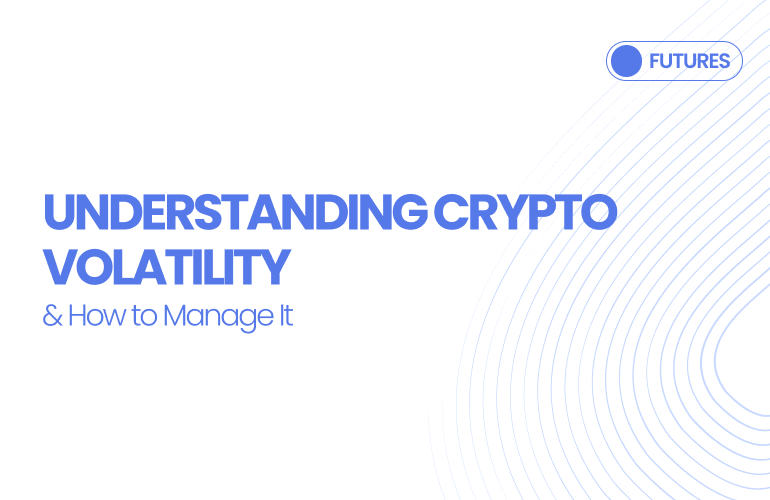What is Crypto Volatility?
Crypto volatility refers to the frequent and unpredictable price fluctuations that characterize the cryptocurrency market. Unlike traditional assets such as stocks or commodities, cryptocurrencies are highly volatile, meaning their prices can experience sharp rises and falls within a short period. While volatility presents risks for investors, it also creates opportunities for traders who can capitalize on rapid price movements.
What Makes Crypto Volatile?
Several key factors contribute to the volatility of cryptocurrencies:
- Decentralised Nature – Unlike fiat currencies controlled by central banks, cryptocurrencies operate on decentralised networks. This means that their prices are entirely dictated by market demand and supply, making them more susceptible to extreme fluctuations.
- Liquidity Issues – The crypto market has relatively lower liquidity compared to traditional financial markets. Lower liquidity means that large trades can cause significant price movements.
- Market Size – The cryptocurrency market is still in its early stages compared to stock markets, making it more vulnerable to market manipulation and price swings.
Why is Crypto Volatile?
Market Sentiment and Speculation
Cryptocurrency prices are highly driven by market sentiment and speculation rather than just fundamental factors. Factors influencing sentiment include:
- Social Media & News Coverage – Positive news, such as institutional adoption or regulatory approvals, can trigger bullish rallies, while negative news like bans or security breaches can cause panic selling.
- Market Hype – Unlike stocks, which have quarterly earnings reports and audited financials, many cryptocurrencies are valued based on hype, speculation, and perceived utility.
- FOMO (Fear of Missing Out) – Crypto FOMO drives investors to rush in when they see a coin’s price rising rapidly, further pushing up the price. However, when the price starts falling, panic selling ensues, amplifying volatility.
Learn More: How to Avoid Crypto FOMO
Lack of Regulation
The absence of a unified regulatory framework makes crypto markets more prone to sudden and unpredictable fluctuations. Here’s why:
- Unregulated Exchanges & Manipulation – Many crypto exchanges operate with minimal oversight, making them vulnerable to price manipulation schemes like pump-and-dumps.
- Regulatory Uncertainty – Governments worldwide are still developing their policies on crypto. A sudden ban, tax imposition, or restrictive regulation can cause massive sell-offs.
- Absence of Investor Protection – Unlike stock markets, where regulations protect investors, the crypto space has fewer safeguards, leading to greater price volatility.
Technological Developments
Cryptocurrencies are built on evolving technology, and any major technological development can drive volatility. Some examples include:
- Blockchain Upgrades & Hard Forks – When cryptocurrencies undergo major upgrades (e.g., Ethereum moving to ETH 2.0), uncertainty around adoption can cause volatility.
- DeFi & Smart Contracts Growth – Decentralized finance (DeFi) applications introduce new use cases, attracting large investments, but also pose risks such as hacks and smart contract failures.
- Security Breaches & Exchange Hacks – Crypto markets are highly reactive to news about exchange hacks or security vulnerabilities, leading to panic selling.
Influence of Institutional Investors
The entrance of institutional investors into the crypto market has significantly impacted volatility:
- Large Volume Trades – Institutions execute high-volume trades, and when they enter or exit a market, prices can swing dramatically.
- Market Manipulation Risks – Institutional investors sometimes use whale trading strategies to manipulate prices in their favour.
- Institutional Adoption Effects – When large companies or investment funds announce support for Bitcoin or Ethereum, it creates bullish momentum, attracting more investors.
How to Manage Cryptocurrency Volatility
While volatility is a core feature of crypto, investors and traders can minimize risks using different strategies.
Risk Management Strategies
- Use Stop-Loss Orders – Setting a stop-loss prevents excessive losses by automatically selling assets when they fall below a specific price.
- Diversify Your Portfolio – Instead of investing in one cryptocurrency, spreading investments across multiple coins reduces risk.
- Manage Leverage Wisely – Using high leverage can amplify both gains and losses. Pi42 provides up to 75x leverage, but traders should use it with caution.
Long-Term vs. Short-Term Investing
- Long-Term Investors (HODLers) – Long-term investors ignore short-term volatility and focus on fundamentals, adoption, and future growth.
- Short-Term Traders – Short-term traders capitalize on daily or hourly price fluctuations to generate profits. They rely heavily on technical analysis and indicators like Bollinger Bands and RSI.
- Swing Trading – A strategy that aims to profit from medium-term price swings, rather than daily fluctuations.
Using Stablecoins to Hedge Against Volatility
Stablecoins like USDT, USDC, and DAI offer traders a way to hedge against extreme volatility:
- Safe Haven During Market Crashes – Investors can convert their holdings into stablecoins to preserve capital.
- Easier Entry & Exit in the Market – Using stablecoins allows traders to quickly enter and exit positions without converting funds into fiat currency.
- Lower Volatility Risks – Unlike Bitcoin and Ethereum, stablecoins are pegged to traditional fiat currencies, reducing price fluctuations.
Conclusion
Crypto volatility is a natural characteristic of the market, influenced by factors such as market sentiment, speculation, regulatory uncertainty, technological developments, and institutional activity. While high volatility creates risks, it also presents opportunities for traders who understand how to manage it effectively.
Platforms like Pi42, India’s first Crypto-INR perpetual futures trading platform, allow traders to capitalize on volatility while benefiting from no 1% TDS, no 30% flat tax, and up to 75x leverage. By implementing risk management strategies, understanding market trends, and using stablecoins for protection, investors can navigate the crypto market with greater confidence and profitability.
More on Crypto Trading
Option Greeks Explained: Delta, Gamma, Theta, Vega, Rho
Understanding Crypto Options Liquidity and Slippage: Orderbooks Explained
What Are Altcoins: Understanding Their Importance and Impact
How to Trade in Cryptocurrency in India and Actually Make Profit

